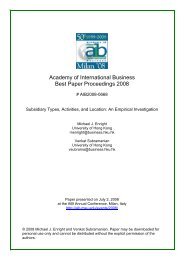AIB 2012 Conference Proceedings - Academy of International ...
AIB 2012 Conference Proceedings - Academy of International ...
AIB 2012 Conference Proceedings - Academy of International ...
You also want an ePaper? Increase the reach of your titles
YUMPU automatically turns print PDFs into web optimized ePapers that Google loves.
TUESDAY<br />
economies are also listed as authors on the patents). We test the proposition that global collaboration reflects a<br />
task partitioning strategy to mitigate spillovers within weak IPR regimes in the emerging economies. For a<br />
sample <strong>of</strong> MNE subsidiaries in the telecom and semiconductor industries, our results indicate that whether it<br />
was intended to or not, global collaboration does not mitigate spillovers within the emerging economy and in<br />
fact increases aggregate spillovers outside the MNE. Rather, the high levels <strong>of</strong> global collaboration in MNE<br />
patents in emerging economies like India and China may simply reflect the fact that most <strong>of</strong> their R&D<br />
subsidiaries in these countries may still be relatively young. (For more information, please contact: Suma<br />
Athreye, Brunel University, United Kingdom: suma.athreye@brunel.ac.uk)<br />
The Depth and Breadth <strong>of</strong> <strong>International</strong> Innovation: The Roles <strong>of</strong> Technological Diversity and Degree <strong>of</strong><br />
Innovativeness<br />
Yung-Ching Ho, National Chung Cheng University<br />
Ying-Ying Hsieh, National Chung Cheng University<br />
When does international research and development (R&D) lead to superior performance In this study we<br />
examine the performance implication <strong>of</strong> R&D internationalization by taking into account the technological<br />
diversity and the degree <strong>of</strong> innovativeness. These two aspects cover the breadth and depth <strong>of</strong> innovation, and<br />
shall shed lights on the roles different types <strong>of</strong> innovation play in the overseas R&D-innovation outcome<br />
mechanism. Our hypotheses argue that technological diversity and degree <strong>of</strong> innovativeness negatively<br />
moderate the influence <strong>of</strong> R&D internationalization on innovation performance. They indirectly diminish the<br />
MNCs' ability to gain benefits from R&D internationalization. We analyze an 11-year data set from 2000 to 2010<br />
<strong>of</strong> over 66 Taiwanese publicly listed firms in the semiconductor industry. Although this is only a preliminary<br />
study with further analysis in progress, and the hypotheses not fully supported, we gain a better picture about<br />
the direction and where this work should be proceeding. (For more information, please contact: Ying-Ying<br />
Hsieh, National Chung Cheng University, Taiwan: yy.hsieh@gmail.com)<br />
Innovation and <strong>International</strong> Patenting trends in the Photographic Equipment Industry<br />
John W Clarry, Rutgers University<br />
Innovation is an essential form <strong>of</strong> competition in many industries. Normal innovation is focused on existing<br />
customers, but radical or disruptive innovation can create new customers and disrupt markets. This paper uses<br />
patents to track potentially disruptive changes from digital technologies in the photographic equipment industry.<br />
Patent counts indicate new knowledge is unevenly distributed internationally and amongst firms, which<br />
constrains disruption and fosters R&D rivalry. Discrete technological fields in the digital imaging industry<br />
indicate concentration <strong>of</strong> patents from a few nations and firms, especially from Japan. Patenting activities in<br />
the industry are increasing as international sales and production networks grow; but financial returns to patents<br />
and R&D efforts are uncertain due to rapid imitation and disruptive technologies from smartphones. (For more<br />
information, please contact: John W Clarry, Rutgers University, USA: jc1418@andromeda.rutgers.edu)<br />
Are Dynamic Capabilities Influenced by the Geographical Location <strong>of</strong> Company Headquarters<br />
Elzotbek Rustambekov, Old Dominion University<br />
This is a conceptual paper, which looks at dynamic capabilities as a specific type <strong>of</strong> knowledge that is<br />
geographically localized. Dynamic capabilities are knowledge-based processes that are developed over time by<br />
means <strong>of</strong> interactions among company's resource bundles and capabilities. Dynamic capabilities enhance a<br />
company's capacity to leverage resources and organizational processes to increase pr<strong>of</strong>itability. Corporate<br />
headquarters were selected as a unit <strong>of</strong> analysis because <strong>of</strong> their knowledge-intensive nature. Empirical<br />
evidence suggests that about six percent <strong>of</strong> headquarters relocate every year and reasons for relocations are<br />
different than just tax incentives (Voget, 2010). It is argued that geographical proximity <strong>of</strong> headquarters<br />
causes spillover <strong>of</strong> operational knowledge during interactions between managers. That operational knowledge<br />
<strong>AIB</strong> <strong>2012</strong> <strong>Conference</strong> <strong>Proceedings</strong><br />
Page 239

















